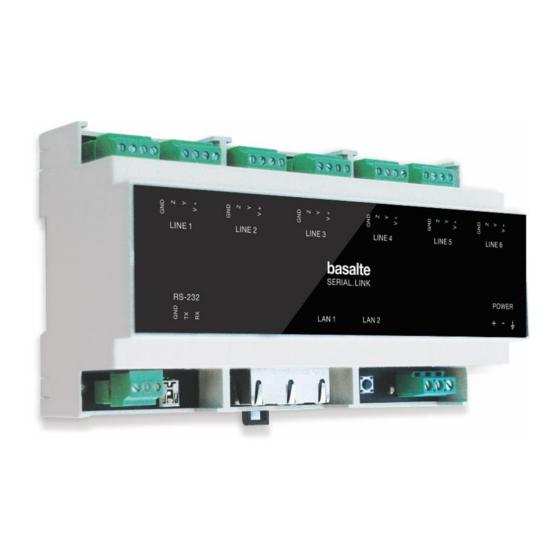
Subscribe to Our Youtube Channel
Summary of Contents for Basalte Serial.link
- Page 1 Serial.link Manual Manual Serial.link basalte bvba hundelgemsesteenweg 1a 9820 merelbeke belgium 1 / 12 v.1.3 © 2018 basalte...
-
Page 2: Table Of Contents
General ........................3 Introduction ....................... 3 Topology ......................4 Sentido Keypads ....................5 Auro Motion sensors ................... 6 Serial.link – hardware overview................7 Communication settings ..................... 8 RS232 ....................... 8 Ethernet ......................9 Firmware upgrade ....................11 Troubleshooting ....................... 12 2 / 12 v.1.3... -
Page 3: General
1.1 Introduction The Basalte Serial.link is a control interface to connect Basalte RS485 keypads and Auro motion sensors with a home automation processor. The Serial.link supports a total of 6 x RS485 lines with a maximum of 32 devices per line. -
Page 4: Topology
(which need to be a shielded pair). For example: shielded twisted pair (STP).Lutron ® bus cable is a suitable RS485 bus cables. The Serial.link requires a power supply between 10 and 30V DC. A power supply of 24V DC is recommended. Power consumption Serial.link: Power consumption Sentido keypad: Power consumption Auro motion sensor: 0.5W... -
Page 5: Sentido Keypads
On all devices the TER switch should be switched “off” (termination disabled), except on the last device per line (endpoint) the TER switch should be “on”. • Configure the RS485 address with the two rotary dials. Please note that the address is in hexadecimal notation. 5 / 12 v.1.3 © 2018 basalte... -
Page 6: Auro Motion Sensors
Important remarks concerning installation: • Configure the RS485 address prior to installing the sensor into the ceiling. The assigning and testing of Auro addresses can be done using the Serial.link configuration tool (see separate application note for Lutron ® ). Please note that the address is in hexadecimal notation. -
Page 7: Serial.link - Hardware Overview
Serial.link Manual 1.5 Serial.link – hardware overview Dimensions The Serial.link is a 9-DIN rail module (158mm or 6 7/32 inches wide), 90mm high and 58mm deep. Status LED (1) The central LED will report the status of the Serial.link: •... -
Page 8: Communication Settings
Ground Pin 5 Note: The ground of the Serial.link must be connected with the ground of the home automation processor. When using a processor as master device and the serial hub as a slave, the RX from the master is the TX from the slave. -
Page 9: Ethernet
2.2 Ethernet The Serial.link will obtain an IP address automatically through DHCP. If the DHCP server can’t provide an IP or is unavailable, the Serial.link will be on a fixed IP address after a delay of 20 seconds (192.168.2.241). The Serial.link configuration tool allows you to discover Serial.links on the local network and change the IP configuration. - Page 10 Serial.link Manual In case the Serial.link can’t be discovered automatically, you can enter the IP address manually using the Add manually button. By pressing the Flash button, the corresponding Serial.link will start flashing green for 5 seconds. Finally select the Serial.link and press Select to continue configuring the Serial.link Ethernet settings.
-
Page 11: Firmware Upgrade
Serial.link Manual 3. Firmware upgrade The firmware of the Serial.link can be upgraded using the Serial.link configuration tool. Select the new firmware file (extension .lfw) and click the Upgrade button to start the upgrade. 11 / 12 v.1.3 © 2018 basalte... -
Page 12: Troubleshooting
A line is tapped into Check the bus for possible branches multiple sections No power on all lines • Short-circuit on one of Disconnect all lines from the Serial.link the power lines and check each line for possible short- circuits. • Power supply not Disconnect all lines from the Serial.link...



Need help?
Do you have a question about the Serial.link and is the answer not in the manual?
Questions and answers